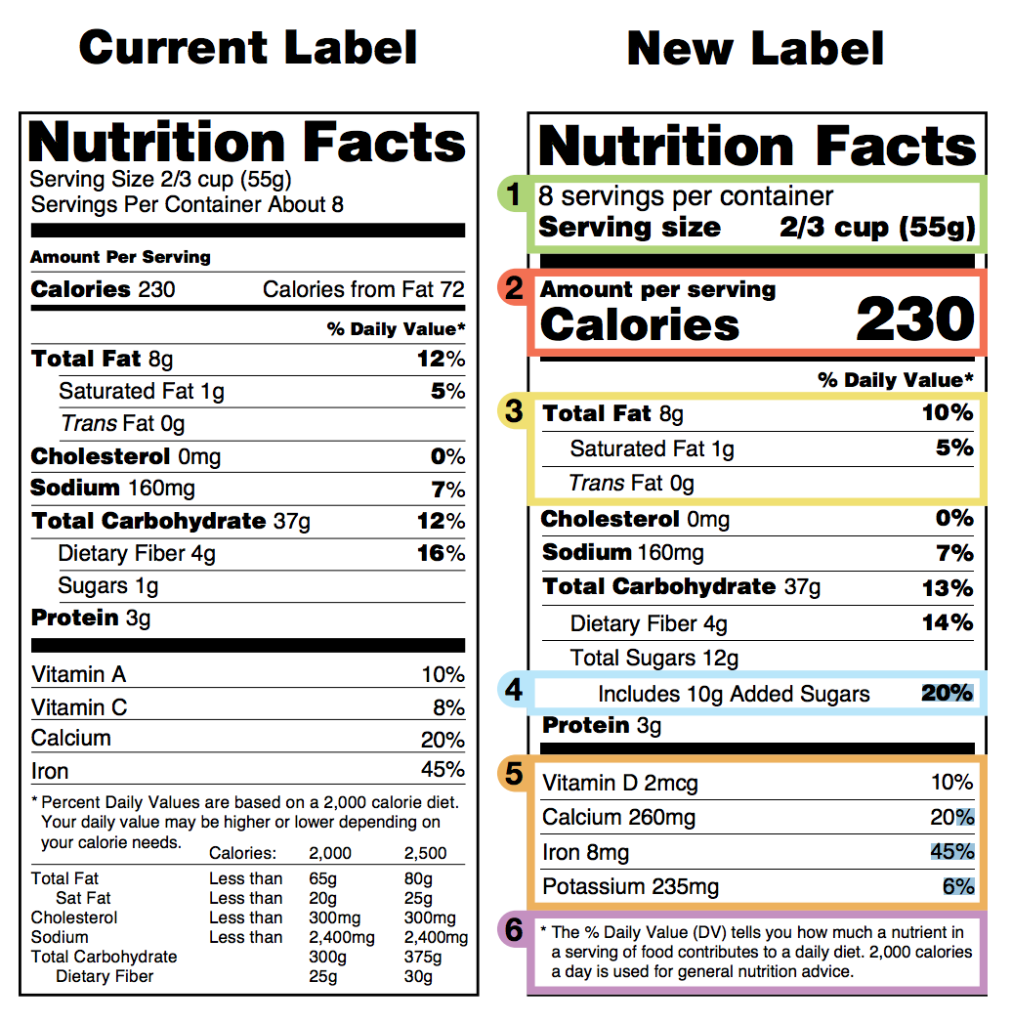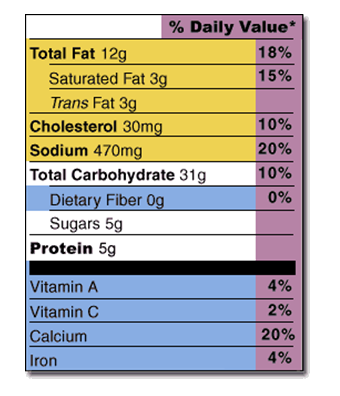43 nutrient requirements that are listed as percentages on food labels
Reading and Understanding Food Labels and Nutrition Info | Beaumont Health Carbohydrates are the main source of energy during most physical activity. Carbohydrates should comprise 50-75 percent of your calories, or about 200-500 grams per day depending on your caloric requirement. Fiber may play as much of a role in disease prevention as fat. Aim for at least 30 grams per day. What are the Requirements for a Food Label? - Short Food Labeling Guide Required Food Label Information. The FDA requires seven areas of information on food labels for legal sale of these goods. These items include the following information about the food product. All labeling must be in English, though some foreign language is appropriate so long as the English translation is also present.
Nutrition Labels Decoded: Tips For Choosing Food Wisely Vitamin D and potassium are now required to be listed since they have been found to be nutrients of concern for Americans. Vitamins A and C will no longer be required but can be included on a voluntary basis. Calcium and iron still remain required. Updating the serving sizes to be more realistic with how much people actually may eat
Nutrient requirements that are listed as percentages on food labels
Food Labeling Requirements - LabelCalc Plugging in our numbers would result in approximately a 13% daily value percentage of Vitamin D expressed in mcg for correct food label formatting: % DV = (2.5 mcg ÷ 20 mcg) × 100 = 13%. Vitamin E. As I'm sure you can guess, Vitamin E and it's various forms were also previously expressed in international units on a food label. The Basics of the Nutrition Facts Label You may need more or less than 2,000 calories per day. This means that you may need more or less than 100% DV that is listed on the package for some nutrients. Low is 5% or less. Aim low in saturated fat, trans fat, cholesterol and sodium. High is 20% or more. Aim high in vitamins, minerals and dietary fiber. The Nutrition Facts Label: Its History, Purpose and Updates - Food Insight There are four vitamins and minerals that are required to be listed on every updated Nutrition Facts label: vitamin D, calcium, iron and potassium. While calcium and iron were also required before the latest update, vitamin D and potassium are new to the list, replacing vitamins A and C.
Nutrient requirements that are listed as percentages on food labels. Food labelling and packaging: Ingredients list - GOV.UK If your food or drink product has 2 or more ingredients (including any additives), you must list them all. Ingredients must be listed in order of weight, with the main ingredient first. Ingredient... Ingredient lists and percentage labelling - Food Standards Ingredients must be listed in descending order (by ingoing weight). This means that when the food was manufactured, the first ingredient listed contributed the largest amount and the last ingredient listed contributed the least. For example, if sugar is listed near the start of the list the product contains a greater proportion of this ingredient. Nutrition Facts Label Size Requirements: LabelCalc Here are some of the common guidelines every food manufacturer should be aware of: "Nutrition Facts" lettering must be bigger than any other font on the nutrition label (except for the numerical value for calories) and must span the length of the whole nutrition facts panel. The smallest font sizes that can be used on the nutrition facts label are 6 point (for the lettering below vitamins, minerals, and footnotes) and 8 point (for the rest of the label). How to Understand and Use the Nutrition Facts Label | FDA Dietary fiber, vitamin D, calcium, iron ad potassium are nutrients on the label that Americans generally do not get the recommended amount of. They are identified as nutrients to get more of....
Nutrition information panels - Food Standards Nutrition information panels (NIP) on food labels provide information on the average quantity of energy in kilojoules or in kilojoules and kilocalories and these nutrients: protein fat saturated fat carbohydrate sugars sodium - a component of salt. A NIP will include information about other nutrients if a claim is made. Packaging and labelling | Food Standards Agency Quantitative declaration of ingredients (QUID) The QUID tells a consumer the percentage of particular ingredients contained in a food product. This is required where the ingredient or category of... How to Understand Percentages on Food Labels - LetsFixIt Reading the nutrition labels on food is an important step to developing a healthier, balanced diet. The U.S. Food and Drug Administration (FDA) requires food manufacturers to print certain nutritional information. ... Protein percentages are only required if the manufacturer touts the food as "high protein," and sugar percentages aren't ... Nutrition Labels 101: What's Required? What's Optional? Vitamins A and C will no longer be required on the FDA's Nutrition Facts labels (though manufacturers may still include them if they choose), while Vitamin D and Potassium will now be required. The percent of the daily value is expressed in 2% increments from 2-10% of the daily value; in 5% increments from 10 to 50% of the daily value; and in 10% increments if the level is above 50%.
Understanding Food Nutrition Labels | American Heart Association Remember that the information shown in the label is based on a diet of 2,000 calories a day. You may need less or more than 2,000 calories depending upon your age, gender, activity level, and whether you're trying to lose, gain or maintain your weight. When the Nutrition Facts label says a food contains "0 g" of trans fat, but includes ... Food Labels | Nutrition.gov Learn the difference between total sugars and added sugars, and discover how the Nutrition Facts Label can help you choose foods that are lower in added sugars. Folate and Folic Acid on the Nutrition and Supplement Facts Labels Understanding Nutrition Facts on Food Labels - WebMD The percentages next to each nutrient -- such as fat, sodium, fiber, protein -- can help you determine whether a food is "high" or "low" in that nutrient. And 5% or less is considered to be "low,"... Understanding Food Labels | The Nutrition Source | Harvard T.H. Chan ... 20% DV or more of a nutrient per serving is high. Use this amount for nutrients you want more of. For example, if you are trying to eat more nutrients to support bone health, then you may aim for this percentage amount (or higher) for calcium and vitamin D. Use the %DV to quickly compare nutrients in similar products.
Nutrition Facts Labeling — FDA Reader The FDA regulates nutritional information panels, their formats, and requirements. Nearly all packaged products require nutrition information although exemptions do exist. You can calculate the nutrition contents of a food using an online nutrition calculator or via a lab analysis of a food sample.. The requirements for nutrition labels may vary depending on:
Presentation of Nutrition Information on Food Labels - Nutrition ... Use of the descriptive terms on the nutrition information panel would require that micronutrients meet the following or similar criteria: use of very good source of must provide, in a serving, more than 20 percent of the dietary standard for a given vitamin or mineral; use of good source of must provide, in a serving, 11 to 20 percent of the dietary standard for a given nutrient; use of contains must provide, in a serving, between 2 and 10 percent of the dietary standard for any nutrient ...
Nutrition labelling - Food Safety It must provide the energy value and the amounts of fat, saturates, carbohydrate, sugars, protein and salt of the food. The declaration must be presented in a legible tabular format on the packaging. Where space does not permit it, the information may be presented in linear format.
Nutrition Labelling - Centre for Food Safety - Home Nutrition label must include the information on energy and seven nutrients specified for labelling (1+7), namely, protein, carbohydrates, total fat, saturated fatty acids, trans fatty acids, sodium and sugars. Furthermore, the nutrition label must list the amounts of any claimed nutrients.


Post a Comment for "43 nutrient requirements that are listed as percentages on food labels"